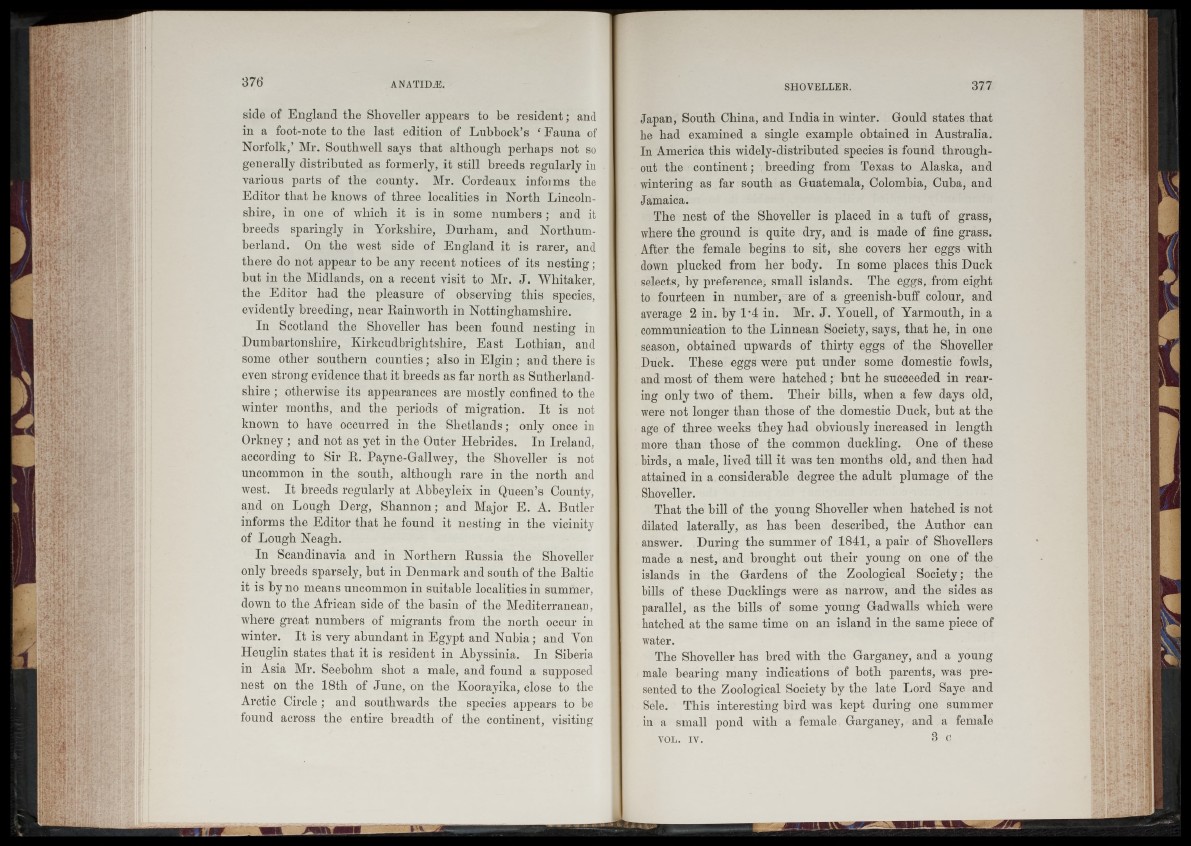
side of England the Shoveller appears to be resident; and
in a foot-note to the last edition of Lubbock’s £ Fauna of
Norfolk,’ Mr. Southwell says that although perhaps not so
generally distributed as formerly, it still breeds regularly in
various parts of the county. Mr. Cordeaux infoims the
Editor that he knows of three localities in North Lincolnshire,
in one of which it is in some numbers; and it
breeds sparingly in Yorkshire, Durham, and Northumberland.
On the west side of England it is rarer, and
there do not appear to he any recent notices of its nesting;
but in the Midlands, on a recent visit to Mr. J. Whitaker,
the Editor had the pleasure of observing this species,
evidently breeding, near Rainworth in Nottinghamshire.
In Scotland the Shoveller has been found nesting in
Dumbartonshire, Kirkcudbrightshire, East Lothian, and
some other southern counties; also in Elgin ; and there is
even strong evidence that it breeds as far north as Sutherland-
sliire ; otherwise its appearances are mostly confined to the
winter months, and the periods of migration. It is not
known to have occurred in the Shetlands; only once in
Orkney ; and not as yet in the Outer Hebrides. In Ireland,
according to Sir R. Payne-Gallwey, the Shoveller is not
uncommon in the south, although rare in the north and
west. It breeds regularly at Abheyleix in Queen’s County,
and on Lough Derg, Shannon; and Major E. A. Butler
informs the Editor that he found it nesting in the vicinity
of Lough Neagh.
In Scandinavia and in Northern Russia the Shoveller
only breeds sparsely, hut in Denmark and south of the Baltic
it is by no means uncommon in suitable localities in summer,
down to the African side of the basin of the Mediterranean,
where great numbers of migrants from the north occur in
winter. It is very abundant in Egypt and Nubia; and Yon
Heuglin states that it is resident in Abyssinia. In Siberia
in Asia Mr. Seebohm shot a male, and found a supposed
nest on the 18tli of June, on the Koorayika, close to the
Arctic Circle ; and southwards the species appears to be
found across the entire breadth of the continent, visiting
Japan, South China, and India in winter. Gould states that
he had examined a single example obtained in Australia.
In America this widely-distributed species is found throughout
the continent; breeding from Texas to Alaska, and
wintering as far south as Guatemala, Colombia, Cuba, and
Jamaica.
The nest of the Shoveller is placed in a tuft of grass,
where the ground is quite dry, and is made of fine grass.
After the female begins to sit, she covers her eggs with
down plucked from her body. In some places this Duck
selects, by preference, small islands. The eggs, from eight
to fourteen in number, are of a greenish-buff colour, and
average 2 in. by 1*4 in. Mr. J. Youell, of Yarmouth, in a
communication to the Linnean Society, says, that he, in one
season, obtained upwards of thirty eggs of the Shoveller
Duck. These eggs were put under some domestic fowls,
and most of them were hatched; hut he succeeded in rearing
only two of them. Their hills, when a few days old,
were not longer than those of the domestic Duck, hut at the
age of three weeks they had obviously increased in length
more than those of the common duckling. One of these
birds, a male, lived till it was ten months old, and then had
attained in a considerable degree the adult plumage of the
Shoveller.
That the hill of the young Shoveller when hatched is not
dilated laterally, as has been described, the Author can
answer. During the summer of 1841, a pair of Shovellers
made a nest, and brought out their young on one of the
islands in the Gardens of the Zoological Society; the
bills of these Ducklings were as narrow, and the sides as
parallel, as the hills of some young Gadwalls which were
hatched at the same time on an island in the same piece of
water.
The Shoveller has bred with the Garganev, and a young
male bearing many indications of both parents, was presented
to the Zoological Society by the late Lord Saye and
Sele. This interesting bird was kept during one summer
small pond with a female Garganey, and a female
3 c
in a